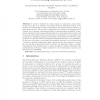Free Online Productivity Tools
i2Speak
i2Symbol
i2OCR
iTex2Img
iWeb2Print
iWeb2Shot
i2Type
iPdf2Split
iPdf2Merge
i2Bopomofo
i2Arabic
i2Style
i2Image
i2PDF
iLatex2Rtf
Sci2ools
113
Voted
ICLP
2004
Springer
2004
Springer
Protein Folding Simulation in CCP
A protein is identified by a finite sequence of aminoacids, each of them chosen from a set of 20 elements. The Protein Structure Prediction Problem is the problem of predicting the 3D native conformation of a protein, when its sequence of aminoacids is known. This problem is fundamental for biological and pharmaceutical research. Due to intrinsic computational limits, no general solution is available. In particular, simulation-based techniques that handle every chemical interaction between all atoms in the aminoacids (and the solvent) involve a huge number of computations. As a consequence, simulation programs of this family run extremely slow. Moreover, these programs are typically written in imperative languages and hard to be parallelized. In this paper we present a novel high-level simulation approach to the problem using concurrent constraint programming. Each aminoacid in the input sequence is viewed as a process that communicates with the others. The framework allows a modular...
Aminoacid | ICLP 2004 | Intrinsic Computational Limits | Programming Languages | Structure Prediction Problem |
Related Content
| Added | 01 Jul 2010 |
| Updated | 01 Jul 2010 |
| Type | Conference |
| Year | 2004 |
| Where | ICLP |
| Authors | Alessandro Dal Palù, Agostino Dovier, Federico Fogolari |
Comments (0)

